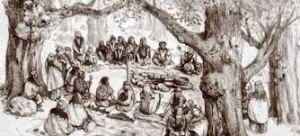I often say “we are smarter than me,”… referring to the increased capacity, deep wisdom, creativity, and solid decisions that groups of people can make – as opposed to one individual acting in isolation. No matter how smart that one person is, in general they will be “outsmarted” but a group of people. That is, of course, if that group of people can work together effectively.
Briskin, Erickson, Ott, and Callanan examine the phenomena of group decision making in their book, The Power of Collective Wisdom: And the Trap of Collective Folly. They answer how groups can come up with novel and powerful solutions to intractable problems at times – and at other times wallow in cobbled together solutions that are amazingly awful.
In a world where our problems are bigger than ever, and where the world is increasing connected, and technology advancements are outpacing our ability to assimilate them, we need to find ways to do more of the former, rather than the latter; to come together in meaningful ways to find creative solutions and ideas.
 Since the early days of humans, people have gathered together to seek answers. First around a fire, then around a table or in a forum. The structure of our democratic government is founded on seeking answers from diverse perspectives across the whole for the collective good. The founding fathers did this brilliantly, yet we see daily how our democratic processes have broken down in America – resulting in collective “folly” rather than wisdom.
Since the early days of humans, people have gathered together to seek answers. First around a fire, then around a table or in a forum. The structure of our democratic government is founded on seeking answers from diverse perspectives across the whole for the collective good. The founding fathers did this brilliantly, yet we see daily how our democratic processes have broken down in America – resulting in collective “folly” rather than wisdom.
Peter Senge describes collective wisdom as “most evident in quiet confidence that our “not knowing” is our strength, that the ability to ask deep questions is more important that offering superficial answers – and that imagination, commitment, patience and openness, and trust in one another will consistently trump IQ over the long haul.”
What distinguishes groups that operate in collective wisdom? They connect deeply, looking for the right action to achieve a higher purpose by inviting new perspectives and broader thinking. They do not rely on the single expert and instead mine the collective experiences. They don’t fragment into functional expertise, but seek integrated perspectives. They don’t isolate decision making, but invite and encourage broad thinking and reflection.
A quote I like from the book: “Wisdom arises in the gaps between what is known and unknown; in the small openings that allow new meanings and perspectives to take hold.” To do so takes suspending what we think we know (expertise), thinking more expansively and honoring different perspectives and ways of knowing.
The authors share specific actions each of us can take to create the space in which collective wisdom can emerge, and warns us of actions that impede this process. Enabling collective wisdom to emerge is neither easy nor fast. It takes moving beyond our own egos. It takes the discipline to really listen rather than expound and defend. It takes getting comfortable with ambiguity, messiness and the unknown. It takes slowing things down and being comfortable in non-linear group processes.
If you are interested in helping nurturing collective wisdom in the groups you are a part of, you’ll want to do a deeper dive by reading the book. In the meantime, here is a short list of actions you can take to improve the chances that your next group decision will be grounded in wisdom rather than folly.
To Foster Collective Wisdom |
To Foster Collective Folly |
 |
 |
|
|
|
|
|
|
|
|
|
|
|
|
|
|
|
|
|
|
Your choice – which path do you want to take?




